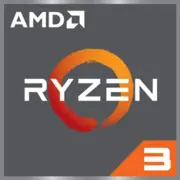AMD Ryzen 3 2200GE

AMD Ryzen 3 2200GE: Budget APU for Basic Tasks and Compact Systems
April 2025
Key Features: Architecture, Performance, and Key Characteristics
The AMD Ryzen 3 2200GE processor, released in 2018, remains a popular choice for budget PCs due to its combination of low power consumption and integrated graphics.
Raven Ridge Architecture and 14nm Process Technology
This APU (Accelerated Processing Unit) is based on the first generation Zen microarchitecture and utilizes GlobalFoundries' 14nm process technology. It is a hybrid chip that combines 4 CPU cores (without multithreading support) and Radeon Vega 8 graphics. A standout feature is the integrated GPU with 8 compute units (512 stream processors), which is uncommon for entry-level processors.
Performance
- Geekbench 6: 681 points (single-core) and 1499 (multi-core). This is sufficient for office tasks, web browsing, and light applications.
- Vega 8 Graphics: In games like CS:GO or Dota 2, it achieves 30–45 FPS on low settings (1080p). In comparison, Intel UHD Graphics 630 in the i3-8100 lags behind by 15–20%.
- TDP 35W: Ideal for compact systems without active cooling.
Cache and Frequency: Base frequency is 3.2 GHz (up to 3.6 GHz in turbo mode), with 4 MB of L3 cache. While it's somewhat limited for multitasking, it's adequate for everyday tasks.
Compatible Motherboards: Sockets and Chipsets
The Ryzen 3 2200GE uses the AM4 socket, providing compatibility with a wide range of motherboards.
Recommended Chipsets
- A320/B350/X370: Budget boards like the ASRock A320M-HDV (price: ~$50–60). They support memory overclocking but not CPU overclocking.
- B450/X470: Options with better VRM (e.g., MSI B450M PRO-VDH Max, ~$70). BIOS updates may be required to support Raven Ridge.
Selection Tips:
- Ensure that the motherboard's BIOS supports the 2000G series APU. Older boards (released before 2018) may need flashing.
- Mini-ITX boards (like the Gigabyte B450 I AORUS PRO WIFI, ~$120) are suitable for compact builds, but they often cost more than the processor itself.
Supported Memory: DDR4 and Dual-Channel Mode
The APU is sensitive to RAM speed because it uses system memory for graphics.
- Memory Type: Only DDR4 (DDR5 is not supported).
- Recommended Frequencies: 2666–3200 MHz. For instance, two Kingston HyperX Fury DDR4-2666 (8GB × 2, ~$45) can provide a 20–25% performance boost in games compared to single-channel mode.
- Maximum Capacity: Up to 64GB (depends on the motherboard).
Power Supplies: Minimum Requirements and Recommendations
With a TDP of 35W, the Ryzen 3 2200GE does not require a powerful PSU.
- Without a discrete graphics card: A 300–400W power supply is sufficient (e.g., EVGA 400 W, ~$35).
- With a graphics card: If you add a GPU like the GTX 1650 later, choose a PSU in the 450–500W range (Corsair CX450, ~$55).
Tip: For quiet systems, consider passive power supplies such as the Seasonic SS-350TGM (350W, ~$70).
Pros and Cons of the Ryzen 3 2200GE
Advantages
- Energy Efficiency: Suitable for mini-PCs and HTPCs.
- Integrated Graphics: Vega 8 outperforms Intel HD/UHD in its price category.
- Price: In 2025, the processor can be found for $70–90 (new).
Disadvantages
- 4 Threads: Multitasking is limited—heavy applications (video editing, 3D rendering) will be sluggish.
- Outdated Process Technology: 14nm versus 7nm for Ryzen 5000/7000.
- No PCIe 4.0: Only PCIe 3.0, which limits NVMe drive speeds.
Usage Scenarios: Where the APU Shines
1. Office PCs and Study: Working with documents, browsing, Zoom.
2. Media Centers: 4K video (with HDMI 2.0 support), streaming.
3. Light Gaming: Fortnite, Rocket League, Minecraft—on low/medium settings.
4. Servers: NAS or home servers due to low TDP.
Limitations: Not suitable for 4K video editing, modern AAA games (like Cyberpunk 2077), or working in Blender.
Comparison with Competitors
Intel Core i3-8100
- Price: ~$80–100.
- Pros: Better single-thread performance (+10–15%).
- Cons: UHD 630 graphics are 30% weaker than Vega 8.
AMD Ryzen 5 2400G
- Price: ~$100–120.
- Pros: 8 threads, Vega 11.
- Cons: TDP of 65W, more expensive.
Conclusion: The Ryzen 3 2200GE excels in the budget segment against Intel due to its graphics but falls short compared to newer APUs like the Ryzen 5 5600G.
Assembly Tips
1. SSD is a Must: Kingston A400 (240 GB, ~$25) will eliminate system slowdowns.
2. Dual-Channel Memory: 2 × 8 GB DDR4-2666 is the minimum for gaming.
3. Cooling: The stock cooler is sufficient, but for quiet operation consider the Deepcool GAMMAXX 400 (~$20).
4. Case: For HTPC use—Silverstone ML05B (Mini-ITX, ~$60).
Final Conclusion: Who is the Ryzen 3 2200GE For?
This processor is suitable for those who:
- Are building a PC for office use, study, or a media center under $300.
- Do not plan to play modern games or use "heavy" programs.
- Value low power consumption and compactness.
As of 2025, the 2200GE remains a niche solution, but for basic tasks, it is still relevant due to its price and integrated graphics. However, if the budget allows, it’s better to consider the Ryzen 5 5600G (6 cores, Radeon Vega 7, ~$150)—it will serve longer.
Basic
CPU Specifications
Memory Specifications
GPU Specifications
Benchmarks
Compared to Other CPU
Share in social media
Or Link To Us
<a href="https://cputronic.com/en/cpu/amd-ryzen-3-2200ge" target="_blank">AMD Ryzen 3 2200GE</a>